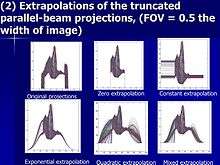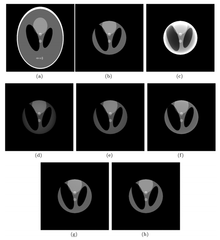Interior reconstruction
In iterative reconstruction in digital imaging, interior reconstruction (also known as limited field of view (LFV) reconstruction) is a technique to correct truncation artifacts caused by limiting image data to a small field of view. The reconstruction focuses on an area known as the region of interest (ROI). Although interior reconstruction can be applied to dental or cardiac CT images, the concept is not limited to CT. It is applied with one of several methods.
Methods
The purpose of each method is to solve for vector in the following problem:

Let be the region of interest (ROI) and be the region outside of . Assume , , , are known matrices; and are unknown vectors of the original image, while and are vector measurements of the responses ( is known and is unknown). is inside region , () and , in the region , (), is outside region . is inside a region in the measurement corresponding to . This region is denoted as , (), while is outside of the region . It corresponds to and is denoted as , ().
For CT image-reconstruction purposes, .
To simplify the concept of interior reconstruction, the matrices , , , are applied to image reconstruction instead of complex operators.
The first interior-reconstruction method listed below is extrapolation. It is a local tomography method which eliminates truncation artifacts but introduces another type of artifact: a bowl effect. An improvement is known as the adaptive extrapolation method, although the iterative extrapolation method below also improves reconstruction results. In some cases, the exact reconstruction can be found for the interior reconstruction. The local inverse method below modifies the local tomography method, and may improve the reconstruction result of the local tomography; the iterative reconstruction method can be applied to interior reconstruction. Among the above methods, extrapolation is often applied.
Extrapolation method

, , , are known matrices; and are unknown vectors; is a known vector, and is an unknown vector. We need to know the vector . and are the original image, while and are measurements of responses. Vector is inside the region of interest , (). Vector is outside the region . The outside region is called , () and is inside a region in the measurement corresponding to . This region is denoted , (). The region of vector (outside the region ) also corresponds to and is denoted as , (). In CT image reconstruction, it has
To simplify the concept of interior reconstruction, the matrices , , , are applied to image reconstruction instead of a complex operator.
The response in the outside region can be a guess ; for example, assume it is

A solution of is written as , and is known as the extrapolation method. The result depends on how good the extrapolation function is. A frequent choice is
at the boundary of the two regions.[1][2][3][4] The extrapolation method is often combined with a priori knowledge,[5][6] and an extrapolation method which reduces calculation time is shown below.
Adaptive extrapolation method
Assume a rough solution, and , is obtained from the extrapolation method described above. The response in the outside region can be calculated as follows:
The reconstructed image can be calculated as follows:
It is assumed that
at the boundary of the interior region; solves the problem, and is known as the adaptive extrapolation method. is the adaptive extrapolation function.[7][8][9][10][5]
Iterative extrapolation method
It is assumed that a rough solution, and , is obtained from the extrapolation method described below:
or
The reconstruction can be obtained as
Here is an extrapolation function, and it is assumed that
is one solution of this problem.[11]
Local tomography
Local tomography, with a very short filter, is also known as lambda tomography.[12][13]
Local inverse method
The local inverse method extends the concept of local tomography. The response in the outside region can be calculated as follows:
Consider the generalized inverse satisfying
Define
so that
Hence,
The above equation can be solved as
- ,
considering that
is the generalized inverse of , i.e.
The solution can be simplified as
- .
The matrix is known as the local inverse of matrix , corresponding to . This is known as the local inverse method.[11]
Iterative reconstruction method
Here a goal function is defined, and this method iteratively achieves the goal. If the goal function can be some kind of normal, this is known as the minimal norm method.
- ,
subject to
and is known,
where , and are weighting constants of the minimization and is some kind of norm. Often-used norms are , , , total variation (TV) norm or a combination of the above norms. An example of this method is the projection onto convex sets (POCS) method.[14] [15]
Analytical solution
In special situations, the interior reconstruction can be obtained as an analytical solution; the solution of is exact in such cases.[16][17][18]
Fast extrapolation
Extrapolated data often convolutes to a kernel function. After data is extrapolated its size is increased N times, where N = 2 ~ 3. If the data needs to be convoluted to a known kernel function, the numerical calculations will increase log(N)·N times, even with the fast Fourier transform (FFT). An algorithm exists, analytically calculating the contribution from part of the extrapolated data. The calculation time can be omitted, compared to the original convolution calculation; with this algorithm, the calculation of a convolution using the extrapolated data is not noticeably increased. This is known as fast extrapolation.[19]
Comparison of methods
The extrapolation method is suitable in a situation where
- and
- i.e. a small truncation artifacts situation.
The adaptive extrapolation method is suitable for a situation where
- and
- i.e. a normal truncation artifacts situation. This method also offers a rough solution for the exterior region.
The iterative extrapolation method is suitable for a situation in which
- and
- i.e. a normal truncation artifacts situation. Although this method gets better interior reconstruction compared to adaptive reconstruction, it misses the result in the exterior region.
Local tomography is suitable for a situation in which
- and
- i.e. a largest truncation artifacts situation. Although there are no truncation artifacts in this method, there is a fixed error (independent of the value of ) in the reconstruction.
The local inverse method, identical to local tomography, suitable in a situation in which
- and
- i.e. a largest truncation artifacts situation. Although there are no truncation artifacts for this method, there is a fixed error (independent of the value of ) in the reconstruction which may be smaller than with local tomography.
The iterative reconstruction method obtains a good result with large calculations. Although the analytic method achieves an exact result, it is only functional in some situations. The fast extrapolation method can get the same results as the other extrapolation methods, and can be applied to the above interior reconstruction methods to reduce the calculation.
See also
| Look up extrapolation in Wiktionary, the free dictionary. |
| Wikimedia Commons has media related to Extrapolation. |
- Forecasting
- Minimum polynomial extrapolation
- Multigrid method
- Prediction interval
- Regression analysis
- Richardson extrapolation
- Static analysis
- Trend estimation
- Interpolation
- Extrapolation domain analysis
- Dead reckoning
- Image reconstruction
- Local inverse
- Generalized inverse
- Extrapolation
Notes
- ↑ M.M. Seger, Rampfilter implementation on truncated projection data. Application to 3D linear tomography for logs,Proceedings SSAB02, Symposium on Image Analysis, Lund, Sweden, 7–8 March 2002. Editor Astrom.
- ↑ F .Rashid-Farrokhi, K.J.R. Liu, C.A. Berenstein and D.Walnut,Wavelet-based Multiresolution Local Tomography, IEEE Transactions on Image Processing 6 (1997), 1412–1430.
- ↑ M. Nilsson, Local Tomography at a Glance, Licentiate Theses in Mathematical Sciences 2003:3 ISSN 1404-028X, ISBN 91-628-5741-X, LUTFMA-2007-2003. Printed in Sweden by KFS AB Lund, 2003.
- ↑ P.S. Cho, A.D. Rudd and R.H. Johnson, Cone-beam CT from width truncated projections, Computerized Medical Imaging and Graphics 20(1) (1996), 49–57, 49–57.
- 1 2 J. Hsieh, E. Chao, J. Thibault, B. Grekowicz, A. Horst, S. McOlash and T.J. Myers, A novel reconstruction algorithm to extend the CT scan fieldofview, Medical Phys 31 (2004), 2385–2391.
- ↑ K.J. Ruchala, G.H. Olivera, J.M. Kapatoes, P.J. Reckwerdt and T.R. Mack, Methods for improving limited fieldofview radiotherapy reconstructions using imperfect a priori images, Med Phys 29 (2002), 2590–2605.
- ↑ M. Nassi,W.R. Brody, B.P.Medoff and A.Macovski, Iterative reconstruction reprojection: an algorithm for limited data cardiac computed tomography, IEEE trans Biomed Engineering 295 (1982), 333–340.
- ↑ J.H. Kim, K.Y. KWAK, S.B. Park and Z.H. Cho, Projection space iteration reconstruction reprojection, IEEE transaction on Medical Imaging 4 (1983), 139–143
- ↑ P.S.Cho, A.D. Rudd and R.H. Johnson, Conebeam CT from width truncated projections Computerized,Medical Imaging and Graphics 20 (1996), 49–57.
- ↑ B. Ohnesorge, T. Flohr, K. Schwarz, J.P. Heiken and K.T. Bae, 2000 Efficient correction for CT image artifacts caused by objects extending outside the scan field of view, Med Phys 27, 39–46.
- 1 2 Shuangren Zhao, Kang Yang, Dazong Jiang, Xintie Yang, Interior reconstruction using local inverse, J Xray Sci Technol. 2011; 19(1): 69-90
- ↑ A. Faridani, E.L. Ritman and K.T. Smith, Local tomography, SIAM J APPL MATH 52 (1992), 459–484.
- ↑ A. Katsevich, 1999 Cone beam local tomography, SIAM J APPL MATH 59, 2224–2246.
- ↑ Ye. Yangbo, Yu. 1 Hengyong 2 and GeWang, Exact Interior Reconstruction from Truncated Limited Angle Projection Data, International Journal of Biomedical Imaging (2008), 1–6.
- ↑ L. Zeng, B. Liu, L. Liu and C. Xiang, A new iterative reconstruction algorithm for 2D exterior fanbeam CT, Journal of XRay Science and Technology 18 (2010), 267–277.
- ↑ Y. Zou and X. Pan, 2004, Exact image reconstruction on PIlines from minimum data in helical conebeam CT, Physics in Medicine and Biology 49(6), 941–959.
- ↑ M. Defrise, F. Noo, R. Clackdoyle and H. Kudo, Truncated Hilbert transform and image reconstruction from limited tomographic data. IOPscience.iop.org, 2006
- ↑ F. Noo, R. Clackdoyle and J.D. Pack, A twostep Hilbert transform method for 2D image reconstruction, Phys Med Biol 49 (2004), 3903–3923.
- ↑ S Zhao, K Yang, X Yang, Reconstruction from truncated projections using mixed extrapolations of exponential and quadratic functions, Journal of X-ray Science and Technology, 2011, 19(2) pp 155–72